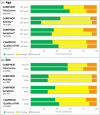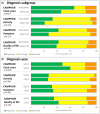Change in health-related quality of life at early follow-up in patients with pulmonary arterial hypertension and chronic thromboembolic pulmonary hypertension
- PMID: 38420145
- PMCID: PMC10899573
- DOI: 10.1002/pul2.12349
Change in health-related quality of life at early follow-up in patients with pulmonary arterial hypertension and chronic thromboembolic pulmonary hypertension
Abstract
Symptoms associated with pulmonary arterial hypertension (PAH) or chronic thromboembolic pulmonary hypertension (CTEPH) impact patient's health-related quality of life (HRQoL). Studies on change and if a minimal clinically important difference (MCID) in HRQoL is reached within a year after diagnosis are lacking. The aim was to investigate the change in HRQoL as well as the proportion of patients that reached MCID at an early postdiagnosis visit. The study included adult patients from the Swedish PAH & CTEPH registry, diagnosed 2008-2021, with Cambridge Pulmonary Hypertension Outcome Review (CAMPHOR) at time of diagnosis and a follow-up. Data were analyzed as total population and dichotomized for sex, age (<65 vs. ≥65 years), time of diagnosis (≤2015 vs. >2015) and pulmonary hypertension (PH) subgroups. Data reported as median, interquartile range (IQR), and proportions (%). There were 151 patients (PAH = 119, CTEPH = 32) with an available CAMPHOR score at diagnosis and follow-up. CAMPHOR total sum was 31 (IQR: 21-43) and 25 (14-36); (p < 0.001) at diagnosis and follow-up, respectively. At follow-up, 56% had reached MCID in total sum, while for domains activity, symptoms, and QoL 27%, 33%, and 39% reached MCID, respectively. These results were independent of PH subgroup, diagnosis before or after 2015 and sex. Age below 65 years was related to improvements in activity and worsening of symptoms. In conclusion on a group level, improvements in CAMPHOR total sum as well as all domains were seen in the first year after diagnosis, however, only slightly more than half of the patients reached MCID for CAMPHOR total sum.
Keywords: chronic illness; disease management; newly diagnosed; patient‐reported outcome measures.
© 2024 The Authors. Pulmonary Circulation published by John Wiley & Sons Ltd on behalf of Pulmonary Vascular Research Institute.
Conflict of interest statement
The authors declare no conflict of interest.
Figures


Similar articles
-
CAMPHOR score: patient-reported outcomes are improved by pulmonary endarterectomy in chronic thromboembolic pulmonary hypertension.Eur Respir J. 2020 Oct 1;56(4):1902096. doi: 10.1183/13993003.02096-2019. Print 2020 Oct. Eur Respir J. 2020. PMID: 32513780
-
From Health-Related Quality of Life (HRQoL) of Patients with Pulmonary Hypertension to Patient Experience with the Care Received: Should We Be More Aware of Current Patient Needs?Adv Ther. 2021 Apr;38(4):1860-1875. doi: 10.1007/s12325-021-01625-w. Epub 2021 Mar 6. Adv Ther. 2021. PMID: 33675523
-
The longitudinal use of EmPHasis-10 and CAMPHOR questionnaire health-related quality of life scores in patients with pulmonary arterial hypertension and chronic thromboembolic pulmonary hypertension.Respir Med. 2021 Sep;186:106525. doi: 10.1016/j.rmed.2021.106525. Epub 2021 Jun 29. Respir Med. 2021. PMID: 34218166
-
A Review of Clinical Trial Endpoints of Patients with Pulmonary Arterial Hypertension and Chronic Thromboembolic Pulmonary Hypertension and How They Relate to Patient Outcomes in the United States.J Manag Care Spec Pharm. 2017 Jan;23(1):92-104. doi: 10.18553/jmcp.2017.23.1.92. J Manag Care Spec Pharm. 2017. PMID: 28025931 Free PMC article. Review.
-
Phosphodiesterase 5 inhibitors for pulmonary hypertension.Cochrane Database Syst Rev. 2019 Jan 31;1(1):CD012621. doi: 10.1002/14651858.CD012621.pub2. Cochrane Database Syst Rev. 2019. PMID: 30701543 Free PMC article.
References
-
- Galiè N, Humbert M, Vachiery JL, Gibbs S, Lang I, Torbicki A, Simonneau G, Peacock A, Noordegraaf AV, Beghetti M, Ghofrani A, Sanchez MAG, Hansmann G, Klepetko W, Lancellotti P, Matucci M, McDonagh T, Pierard LA, Trindade PT, Zompatori M, Hoeper M, ESC Scientific Document Group . ESC/ERS guidelines for the diagnosis and treatment of pulmonary hypertension: the joint task force for the diagnosis and treatment of pulmonary hypertension of the European Society of Cardiology (ESC) and the European Respiratory Society (ERS): endorsed by: Association for European Paediatric and Congenital Cardiology (AEPC), International Society for Heart and Lung Transplantation (ISHLT). Eur Heart J. 2015;2016(37):67–119. - PubMed
-
- Humbert M, Kovacs G, Hoeper MM, Badagliacca R, Berger RMF, Brida M, Carlsen J, Coats AJS, Escribano‐Subias P, Ferrari P, Ferreira DS, Ghofrani HA, Giannakoulas G, Kiely DG, Mayer E, Meszaros G, Nagavci B, Olsson KM, Pepke‐Zaba J, Quint JK, Rådegran G, Simonneau G, Sitbon O, Tonia T, Toshner M, Vachiery J‐L, Noordegraaf AV, Delcroix M, Rosenkranz S, the ESC/ERS Scientific Document Group . 2022 ESC/ERS guidelines for the diagnosis and treatment of pulmonary hypertension. Eur Respir J. 2023;61:2200879. - PubMed
LinkOut - more resources
Full Text Sources

